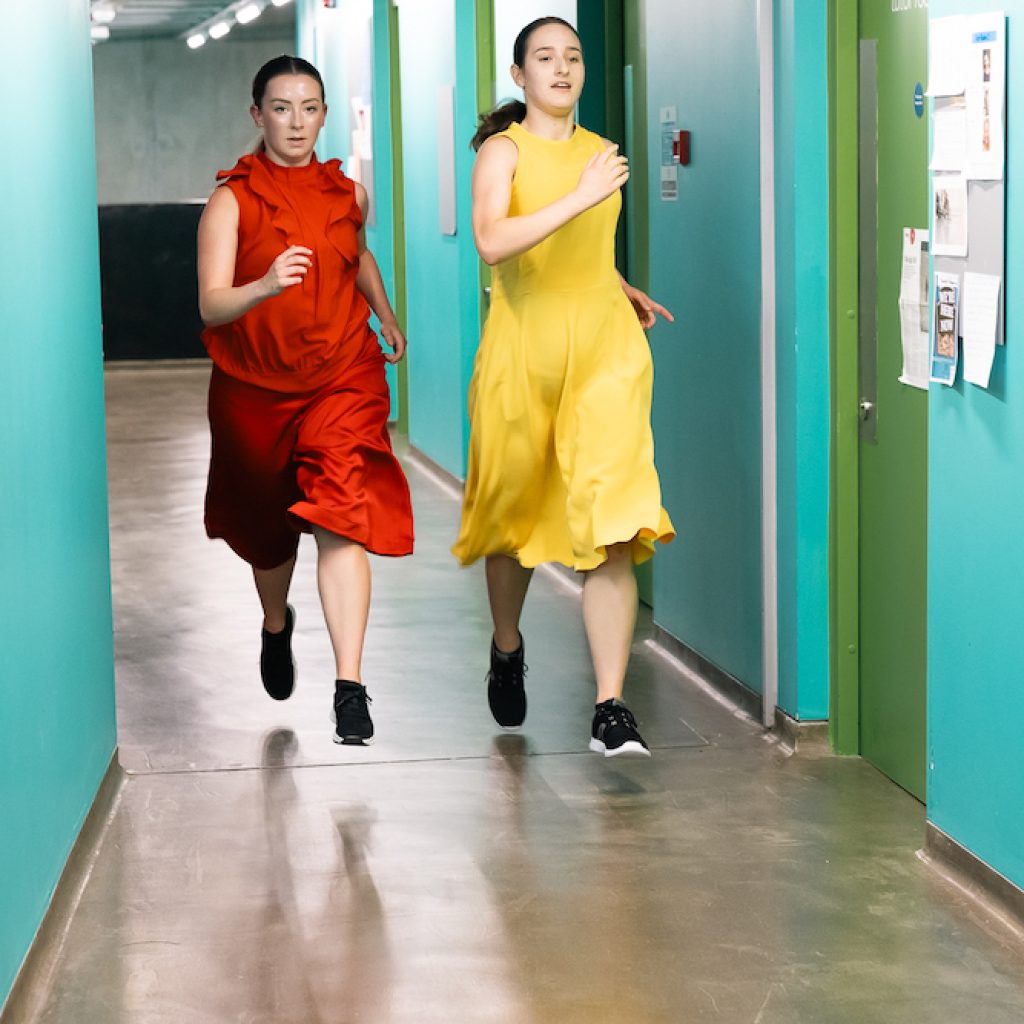Rudolf Laban: it’s one of those names from the annals of dance history that inspires wide eyes and rapt attention. The dance world of 2024, and the broader world in which it resides, is a whole lot different from that which Laban experienced. Under Laban’s storied name, London’s Trinity Laban Conservatoire of Music and Dance is carrying forth the spirit of his legacy: inquiry, rigor and innovation.
As such, it’s not stopping at decades-old achievements; even a quick look into their offerings reveals just how concerted is their commitment to pushing boundaries into the future: those of craft, of creative practice, of the sector and far beyond.

To learn more about how the institution is navigating that tradition/innovation tension, what it’s like to study at Trinity Laban, how it’s all moving forward and more, Dance Informa speaks with two Trinity Laban students and one faculty member. Kaya Blumenthal-Rothchild and Mary Sweetnam are Dance Performance candidates originally hailing from the USA (with Blumenthal-Rothchild on the MFA track and Sweetnam on the MA track), and Hilary Stainsby is the Programme Leader of MA/MFA in Dance Performance.
Why dance, why move, why study? Stepping into the experience
Blumenthal-Rothchild chose Trinity Laban, in large part, to focus on performance and have frequent performance opportunities – something that’s not as common in US-based dance MFA programs, she notes. While Sweetnam was studying primarily modern/postmodern at UCLA, a professor recommended a program like Trinity Laban’s. Sweetnam was also excited to continue deepening her performance practice.
Stainsby had been engaged with youth groups for decades, and teaching at the London Contemporary Dance School for 13 years, before the opportunity to teach at Trinity Laban caught her eye. It seemed to have the potential for just the kind of environment in which she wants to be immersed. “I love working with people who love dancing, in any sector! I’ve really enjoyed being part of changemaking,” she says.
A key objective of the program is for “students to learn more about who they are through the act of dancing,” Stainsby explains. “In an ideal world – it’s certainly easier said than done – we want our graduates to be able to create the world in which they want to make or present work…to empower them with that kind of agency.”
She’s not naive to the fact that artists also “need to pay the rent. It’s all in how they can manage fitting it together.” She believes that it’s important to be clear with entering students about all of those realities – and how that might shape their studies, their visions for themselves after they graduate, and beyond.

Stainsby affirms that there’s truly something to speaking about all of that openly. Trinity Laban programme leaders like her are practical and realistic about the challenges lying ahead for graduating students – and they do all that they can to ensure that those artists take the plunge “feeling resourced.”
From curriculum to classroom experience: What it’s like to study at Trinity Laban
Trinity Laban programs are intentionally designed to shore students up to meet dance sector challenges. That starts with clear values, those that are far more aligned with the modern world than with the dance sector of yesteryear. A commitment to an egalitarian, non-hierarchical environment is one. “There’s a real push [at Trinity Laban] to make sure that there’s no hierarchy; no one should feel more important than anyone else,” Stainsby affirms.
Collaboration and transdisciplinary practice are other such values. Stainsby notes that there are also intentional efforts to provide “opportunities for collaboration and cross-pollination.” Even more fundamentally, one could argue, Trinity Laban seeks to nurture the artist who shows up – rather than trying to make them into someone else.
“We recognize that students have already done a lot of that work,” of finding their voices as artists and learning about themselves as dancing humans, Stainsby explains. “There is a lot of confronting ourselves…but it’s beyond our remit – as well as desire – to change people.”

It’s one thing for Stainsby as a professor to claim that, and it’s another for students to (unprompted) say the same. “Especially as we move into doing our own research, there’s no desire to make us look like anyone else,” Blumenthal-Rothchild shares. Sweetnam agrees, noting that she feels as if “we’re being supported in who we are, rather than having to fit a specific mold….and I think that’s setting us up to be strong freelance artists.”
One might wonder what, more specifically, that looks like in the classroom. Sweetnam and Blumenthal-Rothchild describe deep conversations on big ideas such as the nature of the contemporary dance sector, the role of the dancer, performativity and what “technique” even is. They’ve discussed how all of that applies to the range of styles that they study, from Release Technique to Cunningham Technique to ballet to Flying Low. Blumenthal-Rothchild notes how the diversity within their cohort – in terms of age, field experience, interests, goals and beyond – makes these conversations all the richer.
Those cohort connections started fairly early, partly out of necessity. “At the beginning of our programme, we had to create and perform a score utilizing the structure of the building…we had to work together as a cohort right away,” Blumenthal-Rothchild recounts. That’s “collectivity” in action – something that Stainsby believes is an important value, and skillset, for working dance artists. Working in isolation is “hard…and lonely,” she underscores.

At the same time, fostering leadership skills is also a concerted programme aim – with efforts such as having students design technique class offerings. Students also have a lot of creative freedom when it comes to their dissertations; it could be anything, from a presentation to choreographing a work to a performance, Blumenthal-Rothchild explains.
Dancing between and through the old and new
Humming through all of that activity, and all of that conversation, is the aforementioned tension between the old and new: between preservation and innovation, tradition and modernity, looking backward and looking forward. Stainsby believes that tension has “many other tensions associated with it – with ethics and aesthetics, with inclusivity and what excellence looks like…it’s all connected.”
What we hold onto and what we let go of as we move forward requires “constant negotiation and processing,” Stainsby holds. At Trinity Laban, that plays out in aspects from faculty selection to curriculum design to assessment and beyond. Another key question, and one that really resonates through all of the above, is “how we value individuality while working towards a collective goal.”
Iterating to maintain the most fruitful balance there is a sincere challenge, but an important one to meet, she adds. “The only way to get there is to make sure that the dialogue is open,” Stainsby asserts. Blumenthal-Rothchild affirms that those discussions happen fairly often at Trinity Laban.
As an example of such discussion, Blumenthal-Rothchild and Sweetnam describe how their classes have included exchanges on what remains useful and relevant within codified modern dance techniques (such as Horton, Limón and Graham). “What we sort of settled on is that these techniques give you a framework, teaching you about how your body works in space…and they keep you fit!” Sweetnam says.
Studying a variety of techniques offers students in their cohort a whole toolbox of such capacities, she notes. For example, Release Technique will build different skills than ballet, and Flying Low still other tools.

All of that said, it feels like the prevailing value is nurturing students who can thrive in an ever-evolving dance sector – and furthermore, shape how that sector evolves. “Our motto used to be ‘preparing students for the realities of the sector,’ and now it’s ‘preparing students to change the sector,’” Stainsby explains. “Change is the only constant, especially post-COVID. Nothing seems to be the same for any length of time!”
Moving forward, literally and metaphorically: Gazing into the future
For their own part, Trinity Laban offerings are morphing and molding. For instance, the Transitions Dance Company was recently rebranded to the Trinity Laban Dance Collective, Stainsby explains. She’s indeed purposeful about that “collectivity” she mentioned. It’s something she’s been thinking about a lot, and has a lot of work to do on still, she says.
That rebrand was also a restructuring, with changes going deeper than the name; the company used to tour with the works of three different choreographers, yet the collective is focused on smaller-scale, community-based projects. That’s reflective of shifts in the wider dance sector, Blumenthal-Rothchild explains. Stainsby is also interested in “more opportunities for students to be involved in decision-making processes,” above and beyond things like designing their own technique class curriculums.
She also often reflects on sustainability – on both economic and environmental levels. “We have to move toward more sustainable models, and get clear on what that looks like. We have to be proactive versus reactive, finding creative versus reductive solutions,” she asserts. It’s all in fruitful flux. “Historically, it’s been quite systematic – but now it feels like we’re finding it all out together, reorganizing it all together,” Stainsby says, with a smile.
For more information on Trinity Laban and the programmes offered, visit www.trinitylaban.ac.uk.
By Kathryn Boland of Dance Informa.














